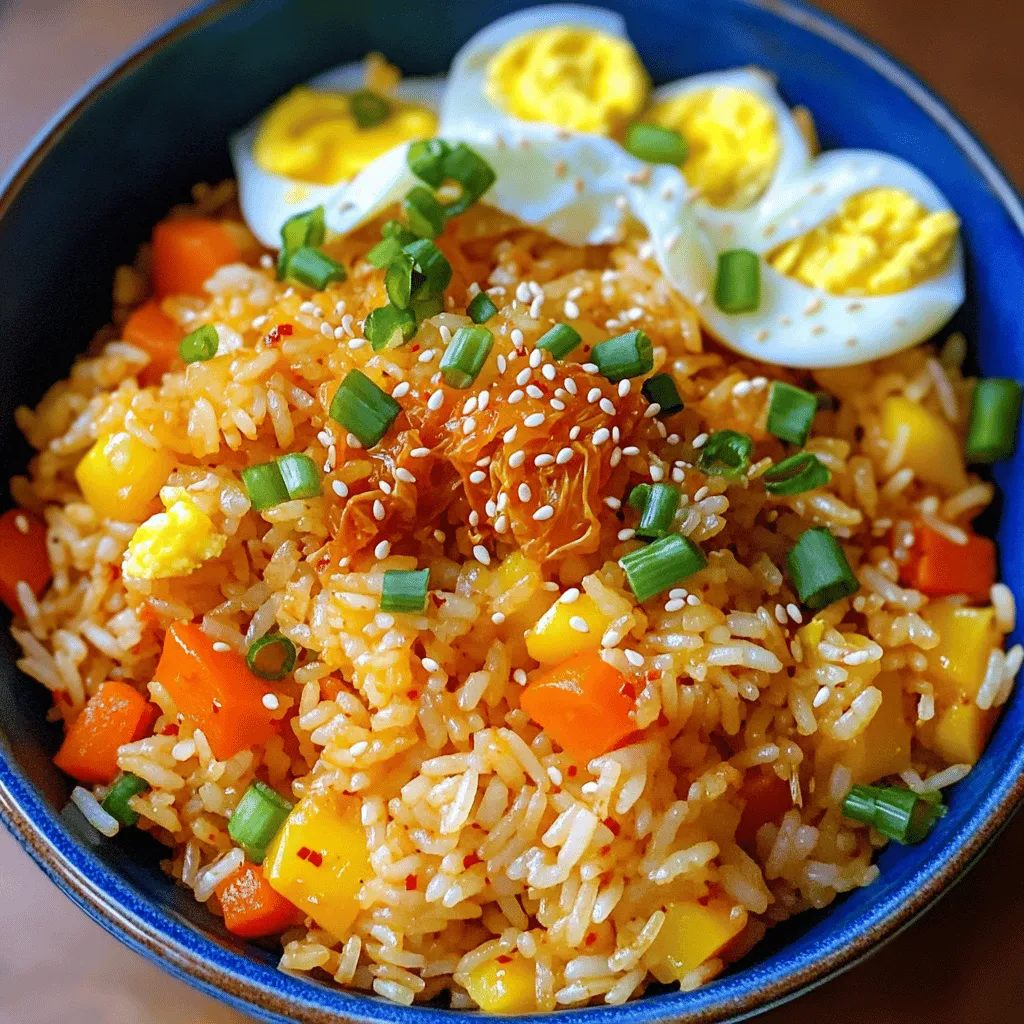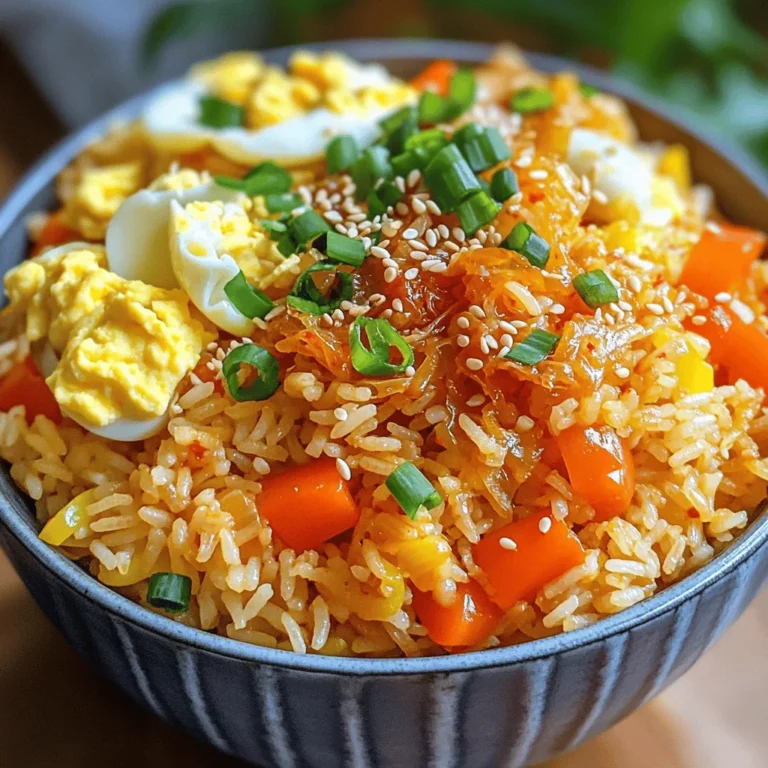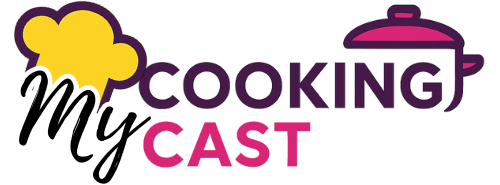If you’re craving a dish that bursts with flavor, you’ve come to the right place! This Spicy Kimchi Fried Rice recipe is not just tasty; it’s simple to make. You’ll learn all about the key ingredients, step-by-step cooking tips, and ways to customize it. Whether you’re a novice in the kitchen or a seasoned pro, you can whip up this delightful meal in no time. Ready to spice things up? Let’s dive in!
Ingredients
List of Ingredients
– 2 cups cooked jasmine rice (preferably day-old)
– 1 cup kimchi, chopped
– 1/2 cup green onions, sliced (reserve some for garnish)
– 1 carrot, diced
– 1/2 cup bell pepper, diced (red or green for color)
– 2 cloves garlic, minced
– 2 tablespoons soy sauce
– 1 tablespoon gochujang (Korean chili paste)
– 1 tablespoon sesame oil
– 2 tablespoons vegetable oil
– 2 large eggs
– Salt and pepper to taste
– Sesame seeds for garnish (optional)
Substitutions for Fresh Ingredients
If you don’t have jasmine rice, use any long-grain rice. You can swap out kimchi for pickled vegetables. If you lack green onions, use chives or shallots instead. For bell peppers, zucchini works great too. If you don’t have gochujang, try sriracha or chili flakes for heat.
Measurement Conversions
– 1 cup = 240 ml
– 1 tablespoon = 15 ml
– 1 teaspoon = 5 ml
– 1/2 cup = 120 ml
These conversions help make your cooking smooth and easy. Always keep a measuring cup handy for best results.
Step-by-Step Instructions
Preparation Tips
Before you start cooking, gather all your ingredients. This makes the process faster. Use day-old jasmine rice for the best texture. Fresh rice can be too sticky. Chop the kimchi, green onions, carrots, and bell peppers ahead of time. This helps them cook evenly.
Cooking Process Breakdown
1. Heat the Oil: Start by heating the vegetable oil and sesame oil in a large skillet over medium-high heat.
2. Cook the Vegetables: Add the diced carrots and bell peppers. Stir-fry for about 3-4 minutes until they soften.
3. Add Garlic and Kimchi: Stir in minced garlic and the chopped kimchi. Cook for another 2-3 minutes. This lets the kimchi caramelize and adds depth to the dish.
4. Add Rice: Turn the heat to high and add the cooked rice. Break up any clumps with your spatula. Mix the rice with the veggies well.
5. Season the Rice: Drizzle soy sauce and gochujang over the rice mixture. Stir to coat the rice in sauce. Season with salt and pepper to taste.
6. Push to One Side: Push the rice mixture to one side of the skillet. This creates space to scramble the eggs.
7. Cook the Eggs: Crack the eggs into the empty space. Scramble them until just set, then mix with the rice.
8. Add the Green Onions: Toss in the reserved green onions. Stir everything together for another minute.
9. Serve Hot: Remove the skillet from heat and serve the fried rice immediately.
Serving Suggestions
Serve the spicy kimchi fried rice in individual bowls. Garnish with sesame seeds and extra green onions for a pop of color. A side of additional kimchi adds a nice touch and enhances the meal. Enjoy your delicious creation!
Tips & Tricks
How to Perfectly Cook Rice
To make great fried rice, start with day-old rice. Fresh rice is too moist. Spread cooked jasmine rice on a plate to cool. This helps it dry out. You can use a rice cooker or a pot. If using a pot, add water and rice in a 2:1 ratio. Bring it to a boil, then cover and simmer for about 18 minutes. Let it sit for 10 minutes after cooking. Fluff with a fork before using.
Enhancing Flavor Profiles
Boost the taste of your fried rice with bold ingredients. Use quality kimchi for a spicy kick. Gochujang adds heat and depth. Pair it with soy sauce for umami flavor. Consider adding sesame oil for a nutty touch. You can also toss in some fresh herbs. Chopped cilantro or basil adds freshness. A splash of lime juice can brighten the whole dish.
Common Mistakes to Avoid
Watch out for overcooking the vegetables. They should be tender but still crisp. Avoid using too much soy sauce; it can make the rice soggy. Stir-fry on high heat to ensure everything cooks quickly. Don’t skip the step of scrambling the eggs separately. Mixing them in at the end keeps them fluffy. Lastly, always taste and adjust seasoning before serving.

Variations
Add-ins for Extra Protein
You can easily boost the protein in your spicy kimchi fried rice. Here are some great options:
– Chicken: Cook diced chicken and add it with the vegetables.
– Tofu: Use cubed tofu for a plant-based protein boost.
– Shrimp: Sauté shrimp until pink and mix them in.
– Beef: Thinly slice beef and stir-fry it for a savory kick.
Adding protein makes it heartier and more filling.
Vegetarian and Vegan Options
If you want a vegetarian or vegan version, you can swap a few ingredients:
– Eggs: Skip the eggs or use tofu scramble instead.
– Kimchi: Make sure your kimchi is vegan, as some contain fish sauce.
– Soy Sauce: Use a gluten-free sauce if needed.
– Vegetables: Add more veggies like broccoli, zucchini, or peas for extra nutrients.
You can still enjoy all the flavor without any meat.
Alternative Seasonings and Sauces
Feel free to play with seasonings to make the dish your own:
– Sriracha: Add sriracha for more heat and flavor.
– Teriyaki Sauce: Use teriyaki for a sweet touch.
– Coconut Aminos: A great soy sauce alternative for a sweeter taste.
– Garlic Powder: Sprinkle garlic powder for extra flavor without fresh garlic.
Experimenting with these options can bring new life to this dish.
Storage Information
How to Store Leftovers
To store leftover spicy kimchi fried rice, let it cool first. Place it in an airtight container. This keeps the rice fresh and tasty. You can store it in the fridge for up to three days. Make sure to label the container with the date. This way, you won’t forget how long it has been in there.
Reheating Tips
When you’re ready to eat your leftovers, use the microwave or stove. If using the microwave, place the rice in a bowl. Add a splash of water to keep it moist. Cover the bowl loosely and heat for 1-2 minutes. Stir halfway through to heat evenly. If using the stove, warm a skillet over medium heat. Add a bit of oil, then stir-fry the rice until it’s hot. This method will help revive the flavors.
Freezing Guide
You can freeze spicy kimchi fried rice for longer storage. Portion the rice into freezer-safe bags or containers. Remove excess air to prevent freezer burn. It can last for up to three months in the freezer. When you want to enjoy it again, thaw it overnight in the fridge. Reheat it using the tips above for the best taste.
FAQs
What is the best type of kimchi to use?
The best type of kimchi is napa cabbage kimchi. It has a great balance of flavor and crunch. You can also use radish kimchi if you like a sharper taste. Look for kimchi that is well-fermented, as this adds depth to your dish. Store-bought options are fine, but homemade kimchi can elevate your meal.
Can I make this dish in advance?
Yes, you can prepare Spicy Kimchi Fried Rice in advance. Cook the rice and veggies, then store them separately in the fridge. This helps maintain texture. When you are ready to eat, just heat it all up in a skillet. Add the eggs at the end to keep them fluffy and fresh.
How do I make Spicy Kimchi Fried Rice less spicy?
To make the dish less spicy, reduce the amount of gochujang. Start with one teaspoon instead of a tablespoon. You can also add more rice to balance the heat. Mixing in some extra veggies or a splash of coconut milk can help tone down the spice level, making it more mild and enjoyable.
This post covered all you need for a great dish. We discussed the key ingredients, offered helpful substitutions, and shared measurement tips. You learned step-by-step cooking instructions and serving ideas to impress. I also revealed useful techniques to avoid common mistakes, plus unique variations to suit your taste. Lastly, we talked about storage and reheating tips, ensuring nothing goes to waste.
Embrace these insights and enjoy crafting your own delicious meals!


